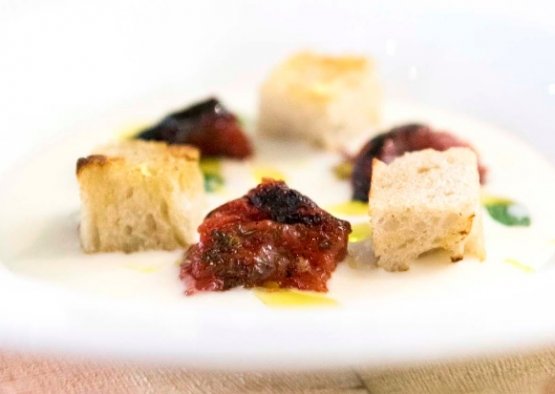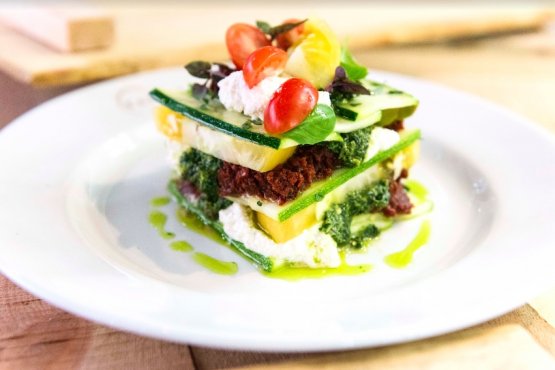It’s the second time Niko Romito participates in Identità New York. Like in 2011, he introduces his origins with his now legendary humbleness: «When my father got sick, I was a student of Business Studies. I went back home with no intention to be a cook: I wanted to sell the restaurant and return to my studies».
He soon changed his mind, though. «At first, everything in the business was hard: Rivisondoli didn’t have as many inhabitants as a skyscraper in New York. I started with a very traditional offer. During the 2-3 following years I started to study to evolve. The usual clients stopped coming. Those were very hard years. But my sister Cristiana and I never gave up: in 2005/06 the first acknowledgements arrived. At the time, Rivisondoli was the smallest town in Italy with two Michelin stars». The rest is recent history.
The style in his self-definition: «My cooking style is rather personal, with a strong identity because it is not linked to a specific school. I try to strike my clients with recognisable ingredients, a more complicate task».
The recipe he made at Eataly Flatiron’s Scuola is a Soup of Grana Padano with peeled tomatoes and stale bread, a dish in the menu at the three Spazio restaurants (Rivisondoli, Rome, Milan): «I couldn’t cook one of my dishes in the menu at Reale because many of these require two or more days of work».

Soup Grana Padano soup with peeled tomatoes and stale bread, a dish in the menu at Niko Romito’s Spazio restaurants: acidity, a note of alcohol and sweetness
The fundamental theme is a double commandment in the cooking of Romito: «Removal of all any sort of fat and clean palate». The method: «I use water instead of cream. We made an emulsion with
Grana Padano, thickened by eliminating the fat from the cream. We add some powdered lentil flour to the water, a natural thickener. The peeled tomatoes are seasoned with salt, sugar, chopped thyme and lemon zest. I put this in the oven at 100°C for one hour and a half, toast it in the pan. Finally I caramelise it with honey and gin».
Last detail, the stale bread: «Toasted in the pan, I add some white wine to give acidity». After collecting all the ingredients in the spoon, the palate of the audience rejoiced thanks to the profound Mediterranean character of the tasting, marked by three pillars: «Acidity, alcoholic note, and sweetness». The final thought is also the most intelligent one: «So as to understand if a dish is good, the most important mouthful is not the first one but the last: it must make you wish to taste some more».
Lesson number two. «In Milan we have a vegetarian chef called Pietro Leemann who last year was struck by Matthew Kenney’s lesson: ‘He’s two more things than me’, he said, ‘a vegan and raw food chef’». This is how Paolo Marchi introduces one of the most famous chefs when it comes to raw food and plant-based philosophy. The author of multiple bestsellers, he’s also a trainer, an entrepreneur (he founded the first real Raw food culinary academy) and the director of a series of important restaurants he owns in the Big Apple and down the East and West Coast.

Courgette lasagne with cherry tomatoes and spicy marinara sauce, the raw-diet first course by Matthew Kenney
«I opened the first restaurant 18 years ago, two blocks away»,
Kenney said at the beginning of the lesson «and we also served duck, chicken and foie gras. Then when I was around 30, when I started with this approach, I had to forget caramelising, boiling, frying, because vegetables really got me excited».
The dish he presented during the lesson is
Courgette lasagne with tomatoes and a spicy marinara sauce, «An excellent transitional dish, for someone who recently became vegan: taste, taste, and taste». There’s tomato sauce, ricotta made with macadamia nuts, a traditional pesto with pistachios («I chose them because they’re crunchier than pine nuts»), courgettes fried in olive oil. The tasting received universal approval in the room.
Matthew, what are your favourite vegetables? «Lemons and potatoes». And your approach when you get the idea for a recipe? «
Keep it simple». Yet it is the final thought that’s the most important one: «If a dish is good, it doesn’t matter how it’s labelled».